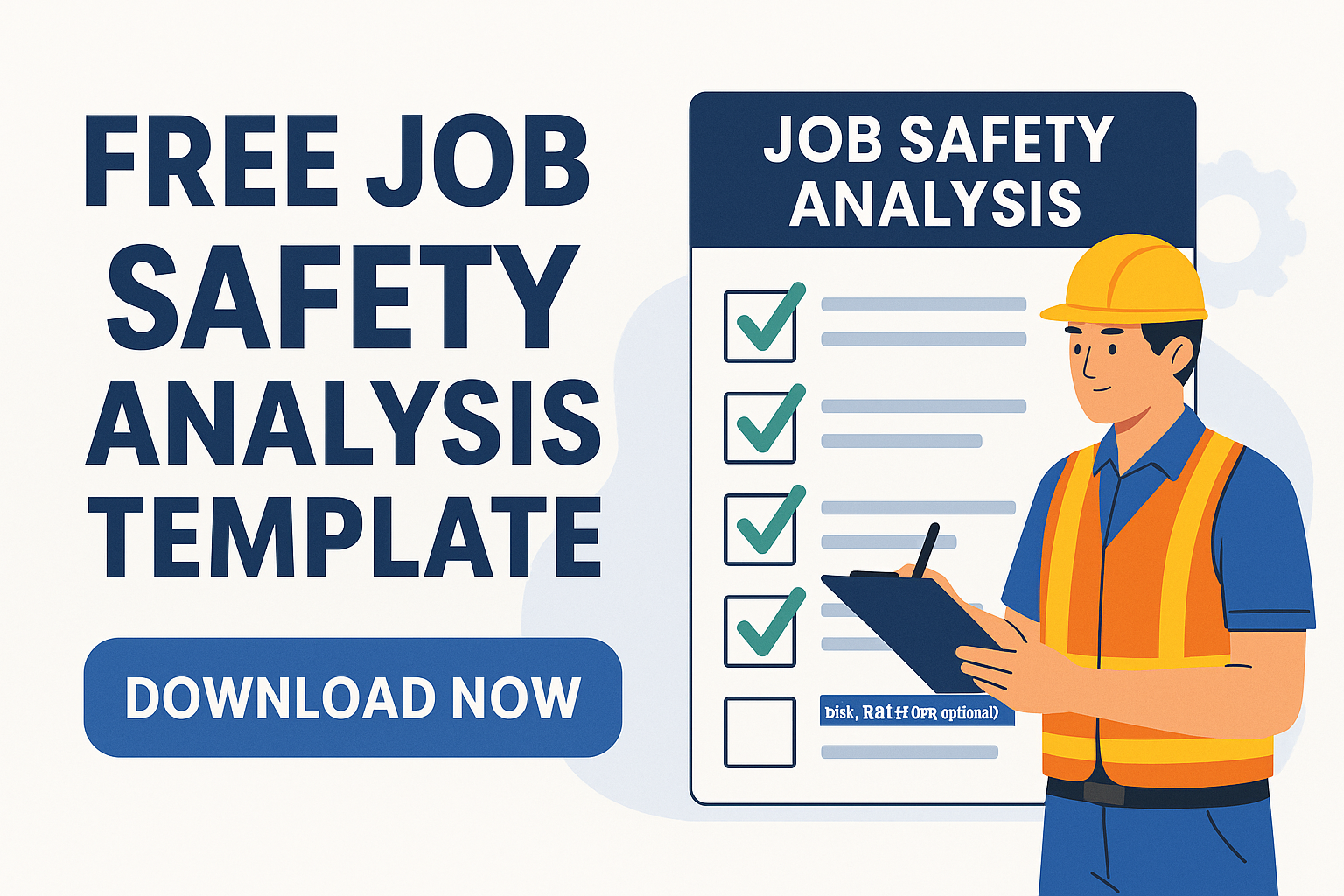
Step-by-Step Guide to Conducting a Job Safety Analysis (JSA) in the Workplace
🧱 Introduction
A Job Safety Analysis (JSA), also known as Job Hazard Analysis (JHA), is a critical process for identifying potential hazards in a specific job task before they cause accidents or injuries. This proactive tool not only helps improve safety compliance but also fosters a culture of awareness and prevention.
Whether you’re managing a construction site, a manufacturing unit, or a maintenance crew, JSA ensures that every job is reviewed systematically for potential risks—before work begins.
🔍 What is Job Safety Analysis (JSA)?
Job Safety Analysis (JSA) is a method that breaks down a job into individual steps, identifies potential hazards in each step, and determines preventive measures to eliminate or control those hazards.
JSA helps to:
- Improve communication among team members
- Identify unsafe work practices
- Ensure compliance with safety regulations (e.g., OSHA, ISO 45001)
- Reduce incidents, injuries, and near misses
🎯 When Should You Perform a JSA?
JSA should be conducted in the following scenarios:
- Before performing high-risk or unfamiliar tasks
- When introducing new equipment or procedures
- After an accident or near miss
- During periodic safety audits
- When hiring new employees
🧭 Step-by-Step JSA Process
Let’s walk through a structured method to conduct a JSA effectively.
📍 Step 1: Select the Job
Choose a job that:
- Has a high injury rate
- Involves many steps or complex procedures
- Includes hazardous equipment or environments
✅ Example: Replacing a faulty circuit breaker in an electrical panel.
📍 Step 2: Break the Job Into Basic Steps
List the main steps of the job in the order they are performed. Avoid too much detail, but ensure each step is clearly defined.
✅ Example:
- Turn off main power supply
- Open electrical panel
- Remove faulty breaker
- Install new breaker
- Close panel and restore power
📍 Step 3: Identify Hazards in Each Step
Now analyze each step to identify associated hazards:
| Job Step | Potential Hazards |
|---|---|
| Turn off main power | Shock from residual current |
| Open electrical panel | Arc flash, flying debris |
| Remove faulty breaker | Electrocution, tool slippage |
| Install new breaker | Wrong wiring, equipment damage |
| Restore power | Sudden power surge, trip hazard |
📍 Step 4: Determine Preventive Controls
For each hazard, determine the control measures using the Hierarchy of Controls (Elimination, Substitution, Engineering, Administrative, PPE).
✅ Example Table:
| Job Step | Hazard | Control Measure |
|---|---|---|
| Turn off main power | Residual electricity | Use lockout/tagout (LOTO) procedures |
| Open panel | Arc flash | Wear arc-rated PPE, face shield |
| Remove breaker | Tool slippage | Use insulated tools |
| Install breaker | Wrong connection | Double-check wiring diagram |
| Restore power | Surge | Stand clear, use voltage tester |
📌 JSA Template (Free Download)
We’ve created a FREE editable JSA Template (PDF) for your workplace.
Includes:
- Job description section
- Task breakdown
- Hazard identification
- Control measures
- Risk level before/after control
- Signatures for accountability
🧠 Real-World Example: JSA in Action
Scenario:
A maintenance worker was scheduled to clean a chemical tank. A Job Safety Analysis was conducted before the job.
Identified Hazards:
- Confined space entry
- Toxic fumes
- Slips from wet surfaces
Control Measures:
- Gas detection and ventilation
- Permit to work system
- Confined space rescue standby team
- Non-slip boots
Outcome: No incidents occurred. Worker completed the task safely and efficiently.
📊 Risk Assessment Matrix (Before/After Controls)
| Hazard | Likelihood | Severity | Risk Level | After Controls |
|---|---|---|---|---|
| Electrocution | Likely | Severe | High | Low |
| Arc Flash | Possible | Major | Medium | Low |
| Fall from Height | Likely | Major | High | Medium |
Use this table to evaluate each hazard both before and after applying controls.
⚠️ Common Mistakes to Avoid
- Skipping JSA for routine jobs
- Not involving frontline workers
- Using generic templates without customization
- Ignoring updates after procedural changes
- Failing to document and review regularly
✅ Benefits of Job Safety Analysis (JSA)
✔ Improves employee awareness
✔ Identifies and eliminates hazards early
✔ Reduces workplace injuries
✔ Enhances training and onboarding
✔ Supports safety audits and compliance
✔ Builds a proactive safety culture
📚 Internal Resources
- 🔗 Daily Construction Site Safety Checklist | Free Template
- 🔗 Free Toolbox Talk Template for Safety Meetings | Download Now
- 🔗 10 Common Risk Assessment Mistakes and How to Avoid Them
- 🔗 How to Conduct a Safety Audit: A Step-by-Step Guide for 2025
- 🔗 Top 7 Types of Risk Assessments Every Workplace Should Conduct
🌐 External References
❓ FAQs: Job Safety Analysis (JSA)
1. Who should conduct the JSA?
Supervisors, safety officers, and workers involved in the task should collaboratively perform the JSA.
2. How often should a JSA be reviewed?
At least annually or after any incident, procedural change, or equipment upgrade.
3. What’s the difference between JSA and Risk Assessment?
A JSA is task-specific, breaking down individual job steps. Risk assessments are broader and may cover entire processes or locations.
4. Can JSA be used as a training tool?
Yes. It’s excellent for new employee onboarding and refresher training on specific job tasks.
5. Is a JSA legally required?
While not always mandatory, JSA is considered a best practice under OSHA and ISO 45001 guidelines.
📌 Final Thoughts
A well-executed Job Safety Analysis is one of the most effective tools for preventing workplace injuries. It empowers your team to recognize hazards before they happen and take responsibility for safety.
Whether you’re managing a team of 5 or 500, implementing JSA consistently will drive safer practices, reduce costs, and support a zero-incident culture.
Download your free template and start conducting smarter, safer JSAs today!





















Best